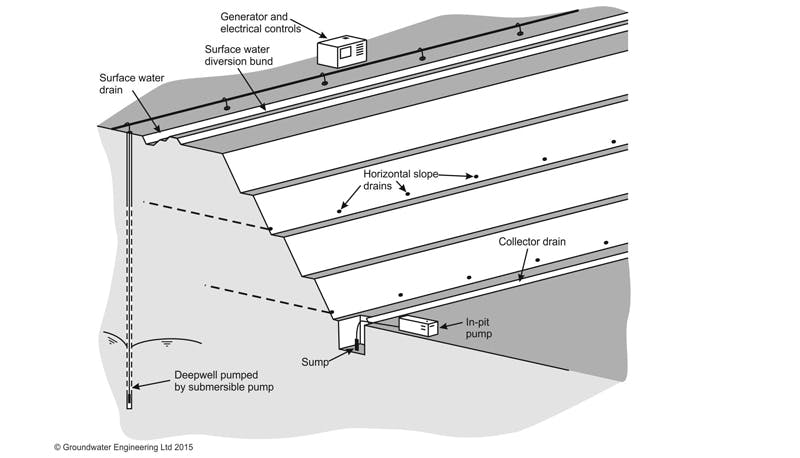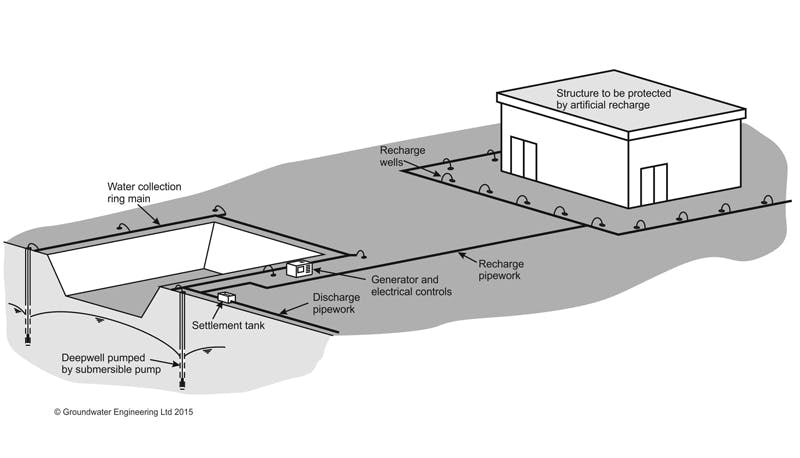Managing Environmental Impacts of Dewatering
16 February 2014Dewatering is the process of dealing with groundwater to allow excavations for construction or mining projects to be carried out in workable dry conditions. When planning dewatering operations it is natural to focus on dealing with groundwater as a problem, and on using the best dewatering technologies to allow safe and efficient construction. However, it is important to recognise that dewatering and groundwater control has the potential to impact on the groundwater environment. The potential environmental impacts from dewatering, and possible mitigation measures, are discussed below.
GROUNDWATER CONTROL TECHNOLOGIES
Dewatering and groundwater control methods can be grouped into two main types: exclusion or pumping.
Groundwater control by exclusion
An impermeable physical cut-off wall is used to exclude groundwater from the excavation. If an impermeable stratum exists at shallow depth beneath the excavation then the cut-off wall can penetrate down to that stratum to create a full cut-off. These types of system tend to have less impact on groundwater regimes because they do not involve significant abstraction of groundwater, and so are often used when the groundwater regime is particularly sensitive.

Groundwater control by pumping
Groundwater is pumped from an array of wells or sumps (located in or around the excavation) with the aim of temporarily lowering groundwater levels to allow excavation to be carried out in dry and stable conditions. These types of system have more potential for significant impacts on groundwater regimes because they are deliberately intended to lower groundwater levels.

IDENTIFICATION OF GROUNDWATER IMPACTS
The type of groundwater impacts which are of potential concern on a given site need to be assessed on a site by site basis, and are broadly controlled by the following factors:
The method of groundwater control
Pumping and exclusion systems have the potential to cause different types of impact, and the specific depth and location of well screens, cut-off walls will strongly influence the type of impact.
The hydrogeological conditions
The aquifer conditions and the presence of any aquitards and aquicludes have a critical effect. For example, if the aquifer is highly transmissive then the distance of influence of pumping will be large and there is the potential for drawdown of groundwater levels to occur at great distances from the dewatering system. Or, if a multiple aquifer system is being dewatered, the presence of aquicludes between the aquifers may restrict the transmission of drawdown impacts from one aquifer to another.
The scale and duration of dewatering
In general terms, long duration dewatering has a greater potential to cause significant impact, compared to short term dewatering. Similarly, dewatering for a deep excavation is more likely to cause notable impacts compared to a shallow excavation. For example, assessment of potential groundwater impacts should be a key part of the design of the dewatering for, say, an open pit mine which may be dewatered to great depth for many years. Conversely, it should be recognized that, say, a shallow excavation for construction of a manhole that may take only a few weeks to complete has much less potential for impact, and may only require a quick review to confirm impacts are not a significant concern.
The site location and surroundings
Environmental impacts are normally assessed for a given ‘receptor’. Receptors can be a particular physical location (such as a farm well or an identified wetland) or a more generic receptor such as water resources in a given aquifer. The site setting will also influence the relevant impacts to be assessed. For example, a dewatering system for a deep basement in the Middle East pumping saline groundwater in an urban environment will have a different set of potential impacts to a dewatering system adjacent to wetlands in a rural setting in Northern Europe.
POTENTIAL GROUNDWATER IMPACTS
There are a wide range of potential impacts from dewatering and groundwater lowering. These can be categorized in various ways, such as the following groups of impact types:
- Geotechnical impacts
- Contamination impacts
- Water dependent feature impacts
- Water resource impacts.
Geotechnical impacts
Dewatering can cause ground settlements which, in some cases can be large enough to cause distress or damage to any structures located within the zone of drawdown. The most common geotechnical mechanism causing this settlement is the increase in effective stress in the soil caused by lowering of groundwater levels, which causes the soil to compress, resulting in ground settlement. Ground settlement is an unavoidable consequence of all cases where groundwater levels are lowered, but in the majority of cases the resulting settlements are too small to be damaging. The cases where settlements may be large enough to cause damage are normally associated with sites where there are significant thicknesses of soft alluvial or post-glacial soils, such as peats or silts.
Settlement can also occur where dewatering is poor executed and where adequate filters are not used at wells and sumps. In these cases fine particles may be drawn out of the soil in the pumped water, this will loosen the soil, and in extreme cases, can create underground voids which can collapse unpredictably and cause localized large settlements. This type of ground settlement should be avoided by good dewatering design, including the use of suitable filters.
Contamination impacts
When groundwater is pumped from wells or sumps, as occurs during some dewatering schemes, hydraulic gradients are generated, which draws the groundwater toward the well. If dewatering is carried out on or near a site which has an historic legacy of groundwater pollution, then these hydraulic gradients may cause the existing contamination to move and migrate toward the dewatering system. If the contaminated area is very close to the dewatering system then contaminated water may emerge in the pumped water, requiring water treatment before it can be discharged.
In urban areas it is not unusual for near surface strata such as Made Ground to contain some contamination, while deeper strata are uncontaminated. In these cases poorly designed and installed dewatering wells and monitoring boreholes can inadvertently allow contamination of deeper strata by providing a downward path for migration of contamination. In these circumstances it is essential that wells are designed to be screened in discrete intervals only, with bentonite seals to vertically separate different strata.
Water dependent feature impacts
Natural groundwater flow plays an important role in sustaining many natural water-dependent features, such as rivers, springs and wetlands. As well as their obvious function in transmitting or storing water, many of these features also form important habitats and ecosystems.
Groundwater control by pumping can potentially intercept groundwater which would normally reach these water-dependent features. If this occurs then river and spring flows may reduce or water levels fall in wetlands and ponds.
There is also the potential for groundwater control by exclusion to affect water-dependent features. If deep and extensive cut-off walls are installed as part of groundwater exclusion schemes may block or divert natural groundwater flow and potentially can have a negative impact on any nearby features.
Water resource impacts
Where dewatering pumping is carried out in an aquifer which is used as a source for water supply by third parties (for example for drinking water or for industrial water use) there can be negative impacts on the available water resources from the aquifer. These types of impacts are most commonly of concern where a dewatering system is to pump high flow rates for extended periods of time (several months or longer). In that case the sustained dewatering pumping may have the potential to lower regional groundwater levels in the aquifer, and reduce the water resources available to third party abstractors. This may be apparent in the short term in the form of lowered water levels in water supply wells and correspondingly reduced yields.
POTENTIAL MITIGATION MEASURES
Any successful measures to mitigate potential impacts from dewatering and groundwater control must be based on a solid understanding of the conceptual hydrogeological model for the site and its environs. The conceptual model should define:
- The aquifer types and potential vulnerability to groundwater impacts
- The depth and extent of the excavation and the proposed method of groundwater control
- The presence of any nearby sensitive groundwater receptors (wetlands, third party water wells, etc)
- The geotechnical properties at the site (compressible strata, etc)
- The presence of any groundwater contamination in the vicinity of the site (not only in the stratum being dewatered, but also in any strata above or below).
The conceptual model should allow identification of the most significant potential groundwater impacts which could result from the proposed dewatering. This should be used to direct the design of the groundwater control system and the associated mitigation and monitoring measures.
To adequately manage potential groundwater impacts, the design process should address the following issues.
Adequate investigation and baseline monitoring
It is essential that the design is based on a thorough site investigation, including a desk study, to allow hydrogeological conditions and environmental receptors to be identified. It is also prudent to have extensive pre-construction monitoring of groundwater levels, spring flows, ground levels, etc to determine baseline conditions against which any impacts can be assessed.
Technology selection
When impacts are of concern, selecting the correct groundwater control technology is essential. If the concern is that groundwater levels may be widely lowered, third party wells affected or groundwater resources depleted, then exclusion methods which reduce or avoid pumping should be considered. Conversely, the barrier effect when cut-off walls of large lateral extent act as dams to groundwater flow may militate against the use of that technique in some circumstances.
Mitigation measures
Engineering measures can sometimes be applied in addition to the main groundwater control system, to minimize the predicted groundwater impacts. The mitigation measures must be developed on a site-specific basis, but could include:
- Artificial recharge: Groundwater from the pumped discharge can be re-injected back into the ground, either to prevent lowering of groundwater levels and corresponding ground settlement, or to prevent depletion of groundwater resources.
- Temporary cut-off walls: If there is a concern that permanent cut-off walls will affect the long term groundwater flow regime, due to the barrier effect, then it may be possible to use temporary cut-off techniques. For example, steel sheet-piles that can be withdrawn at the end of the project, or artificial ground freezing, which will eventually thaw and allow groundwater flow to pass.
- Localized groundwater cut-off walls: Where there is a specific receptor to be protected, such as a wetland or sensitive structure, it may be possible to install a localized section of cut-off wall or grout curtain between the dewatering system and the receptor, to reduce the drawdown at the receptor.
- Protection of individual receptors: If there are only a small number of isolated receptors, it may be more cost effective to simply fix or prevent the problem directly at the receptor, for example by underpinning the foundations of a sensitive structure, or by providing a new piped water supply to replace a well where lowering of water levels has reduced the yield.

Monitoring regime
Monitoring of groundwater levels and pumped flow rates is a necessary part of any groundwater control scheme. However, where environmental impacts are assessed to be of concern then monitoring assumes even greater importance. Additional monitoring may include surveying of ground levels, regular inspection of structures at risk of settlement, water quality monitoring (to assess migration of groundwater contamination) and monitoring of conditions in water-dependent features such as rivers and wetlands.
CONCLUSION
In conclusion, it is important to realize that construction dewatering and mine dewatering projects have the potential to cause a wide range of groundwater impacts. However, thorough investigation, good design and technology selection, followed by good installation practice and suitable mitigation and monitoring can allow dewatering systems to be used even in very sensitive environments.
For more information download Groundwater Engineering’s Technology Data Sheets on Construction Dewatering and Mine Dewatering.
Blog
Dewatering for Basement Construction
12 March 2016Groundwater can be a significant problem when excavating for basement construction. This blog discusses the available techniques that can be used to dewater during basement construction.
Read More




